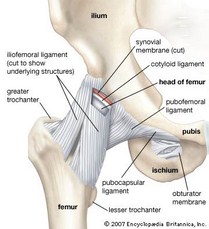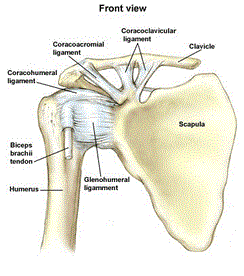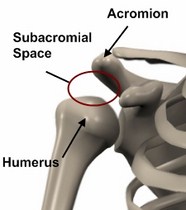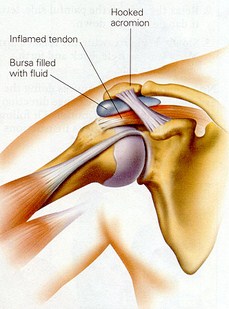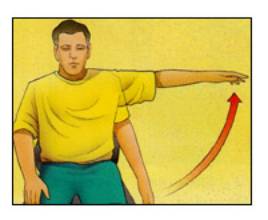Shoulder Impingement Syndrome: Pain and Weakness of the Arm and Shoulder Girdle
by Dr. Nicolas Campos
 In 1996, just before I started chiropractic college, and while still working as a bartender at Bar Marmont (next to the Chateau Marmont) in West Hollywood, I noticed a sharp aching pain in my left shoulder whenever I raised my arm to pour a drink. What started out as a minor, yet significant, discomfort quickly turned into one of the most debilitating conditions I’ve ever experienced. And to make matters worse, my right shoulder soon followed suit in 1997, although it never got as bad as my left shoulder did.I suffered with pain and the inability to lift my arm above my shoulder for four years, every year getting worse than the year before. It got so bad that I couldn’t put my seatbelt on or wash my hair without excruciating pain. You never realize how much you use your shoulders until you lose one of them. I’m sure many of you reading this have experienced, or are experiencing now, what I am talking about: A sharp, almost blinding pain on certain shoulder and arm movements, and a throbbing ache at all other times. And sleep—forget about it: Sleeping on my side was nearly impossible as I woke up in near tears every morning. In 1996, just before I started chiropractic college, and while still working as a bartender at Bar Marmont (next to the Chateau Marmont) in West Hollywood, I noticed a sharp aching pain in my left shoulder whenever I raised my arm to pour a drink. What started out as a minor, yet significant, discomfort quickly turned into one of the most debilitating conditions I’ve ever experienced. And to make matters worse, my right shoulder soon followed suit in 1997, although it never got as bad as my left shoulder did.I suffered with pain and the inability to lift my arm above my shoulder for four years, every year getting worse than the year before. It got so bad that I couldn’t put my seatbelt on or wash my hair without excruciating pain. You never realize how much you use your shoulders until you lose one of them. I’m sure many of you reading this have experienced, or are experiencing now, what I am talking about: A sharp, almost blinding pain on certain shoulder and arm movements, and a throbbing ache at all other times. And sleep—forget about it: Sleeping on my side was nearly impossible as I woke up in near tears every morning.
The worst part of all was that I thought since I was a chiropractic student that I would have encountered someone in my studies who might have been able to help me, but that just wasn’t the case. Not until I met a Certified Chiropractic Sports Physician (thanks Dr. Murray!) was I able to resolve the issue and become pain free within weeks. This experience kick-started my education on shoulder rehabilitation protocols, and it actually motivated me to pursue my postgraduate sports rehabilitation certification. Despite my suffering, some good things came from it all—I’ve become an expert at treating shoulder conditions and have had great success with a large number of patients who have come to see me for that same sore, aching shoulder pain, which becomes sharp on certain movements and prevents them from lifting their arm above their shoulder. There are two conditions that can cause this malady—shoulder impingement and rotator cuff syndrome. In this article I will discuss shoulder impingement, what it feels like and how to correct it. Next month I will post part 2 of this series and discuss the prevalent yet completely treatable rotator cuff syndrome. What Makes Shoulders So Tricky to Treat?Shoulder problems like the one I had can be very difficult to treat for a couple of reasons. One is that we use the shoulders every time we use our arms, so every movement can exacerbate the pain and further the injury. The second reason is that the shoulder joint is actually less stable than most other joints of the body. This seeming aberration in joint biomechanics is necessary to allow for the many movements the shoulder can do. In other words, the shoulder sacrifices stability for mobility . Since the shoulder joint is less stable and we do so many movements with it, it is a structure that is prone to injury.
Most joints are stabilized by ligaments. Ligaments are tough, fibrous bands of connective tissue that are both strong and stable. They are not elastic like muscle tissue, which makes them great for securing bone-to-bone attachments. The hip joint for instance is stabilized by three massive ligaments making it very strong and sturdy; in fact, hip dislocations are not all that common and usually occur from some sort of extreme trauma like motorcycle accidents or falls from significant heights, and they usually come as part of a packagealong with hip or leg fractures.
The shoulder, on the other hand, has very few ligaments supporting it, and the ones that do are relatively small. The majority of the stability that exists in the shoulder comes from the rotator cuff muscles. The rotator cuff is a group of four muscles surrounding the shoulder joint in a cuff-like fashion. When these muscles get weak or injured, problems arise. Rotator cuff muscles get weak when not exercised—go figure. But as simple as that sounds, most people have no idea how to strengthen the rotator cuff, not until they have an injury and come see me, that is.
Shoulder Impingement SyndromeA painful and debilitating injury of the shoulder that I see quite often in my Los Angeles, West Hollywood and Beverly Hills chiropractic practice is impingement syndrome. An impingement syndrome is the pinching-off of anatomical structures usually by a bone or muscle. As a result, they become irritated and inflamed and eventually start to develop scar tissue, which can ultimately diminish their function.
In shoulder impingement syndrome the structures that get pinched off are thesupraspinatus tendon, the long head of the biceps tendon, and the subacromial bursa. Each one of these structures can become inflamed causing either tendonitis or bursitis. The pinching-off of the structures occurs at the subacromial region of the scapula. Theacromion process is a bony prominence that comes of the top of the shoulder blade, or scapula as it’s called. This structure articulates with the collarbone forming a sort of bridge that you can feel at the top of your shoulder. Go ahead, feel it now. It’s the only bony structure there—that’s your acromion process. Just underneath that bridge, or subacromially, lays the two tendons I mentioned above as well as the bursa. Just so you know, a bursa is a fluid filled sac that acts as a shock absorber wherever we have bony prominences—our elbows, knees, butt bones (not the technical term), and shoulders to name a few.
When a shoulder impingement occurs, the person affected will feel a very sharp, almost burning sensation when moving the shoulder. Any movement that irritates this area will cause intense pain, and when irritated, forget about it, the shoulder just flat out hurts—no relief in any position, just pain. When this happens the best thing to do is ice the shoulder right at the acromion; the subacromial region has become inflamed and it’s important to get in there with ice and cool it off. How do you know if you are having shoulder impingement? Well, there are a couple classic signs. First are the symptoms I’ve mentioned above—sharp, burning pain that is worse on movements. One movement in particular, which is pretty standard in causing pain in an impinged shoulder, is shoulder abduction. Shoulder abduction is raising the arm to the side in an arc above the head, just like the arm movements carried out in a jumping jack. The next classic sign is waking up with increased pain after sleeping on one’s side. Although this also happens in rotator cuff syndrome, the distinction in shoulder impingement is that there is pain regardless of which side is slept on, not true with the rotator cuff as you will learn next month.
How to Fix a Shoulder ImpingementYou now have a pretty good idea of whether you’ve got a shoulder impingement or not. So what to do now? Well the first thing you must do is call your local chiropractor. If your local chiropractor happens to practice in Los Angeles, West Hollywood or Beverly Hills then you’re probably calling me. Come in and we’ll do an evaluation and find out exactly what is causing your shoulder pain and injury. As I’ve said before, a shoulder impingement is the clipping-off of the structures sitting beneath the acromion process. As the shoulder moves into abduction (and flexion too incidentally), the supraspinatus tendon, biceps tendon, and the subacromial bursa all get squeezed in the small space in which they reside. This pinching causes the structures to become irritated, inflamed and eventually even scarred. The best and most immediate pain relief will come from using ice. Don’t forget the rule of icing: 15 minutes on, no more, no less. Watch the clock and don’t put the ice directly on your skin—it’ll cause freezer burn. Any more than 15 minutes of ice and you’ll cause the opposite reaction than what is needed. Instead of decreasing inflammation, it will actually increase, as the body will start to enter a state of hypothermia, or frostbite. So keep an eye on the time. Never, ever, ever fall asleep with an ice bag on you—trust me, that would be big mistake. |

